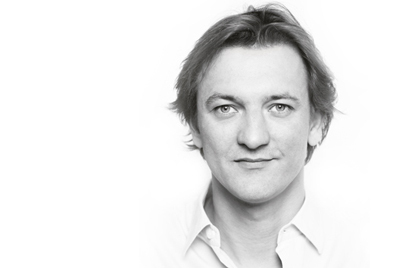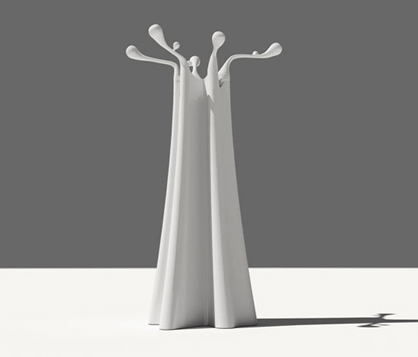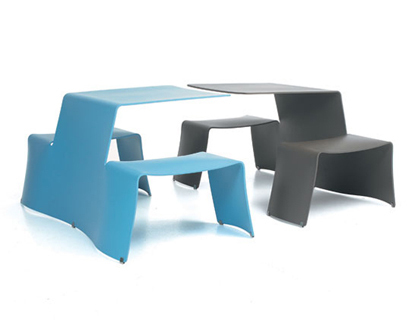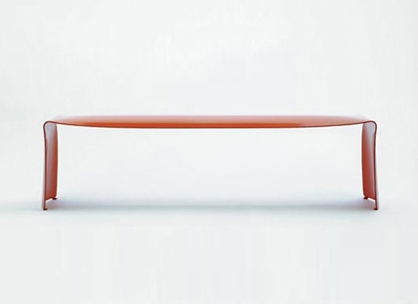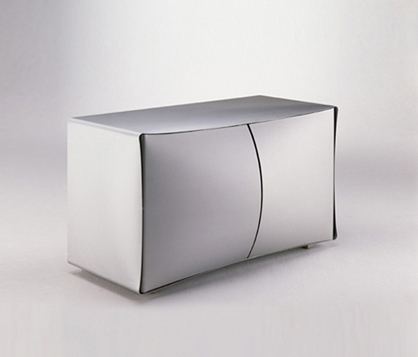Almost 'No Design'
Text by Nora Schmidt
Berlin, Germany
25.06.08
The Belgian designer Xavier Lust has won international recognition with his ingeniously crafted designs. Since achieving his big breakthrough with 'le banc' ten years ago he has produced designs for well-known manufacturers such as MDF Italia, Driade, De Padova and Extremis.
The Belgian designer Xavier Lust has won international recognition with his ingeniously crafted designs. Since achieving his big breakthrough with 'le banc' ten years ago he has produced designs for well-known manufacturers such as MDF Italia, Driade, De Padova and Extremis.
We got together with Xavier Lust during the Salone del Mobile to talk about his work and the development of his studio in Brussels.
We're sitting here at the Triennale, surrounded by a number of world-famous designers whose faces are familiar from the covers of various design magazines. How do you feel in this distinguished company?
It is always a great thing to come to the Salone del Mobile and meet designers from all over the world. Year after year you get to know more of them, and more of them recognize you, which is a nice thing. I particularly appreciate to receive comments directly from colleagues who have seen my work and appreciate it. Designers are becoming more and more like superstars, so to be able to talk to Philippe Starck, Ron Arad or Ross Lovegrove, whom you have casually met at a party, is pretty amazing.
To what extent do you allow yourself and your work to be influenced by the growing interest of the media?
I try to put up some resistance, but the media have become such an important aspect of the designer's work that it's almost impossible to stand aside from it.
For young designers, of course, it's a good opportunity to attract attention.
That's true. They also receive more respect and from this point of view they have it easier today than I had 15 years ago, when I graduated from design school. On the other hand there is also a total overdose of information – above all when it comes to young design. There are also a lot more young designers than in the past. And this increase in quantity has not, unfortunately, led to an increase in quality. I see a lot of young design which I find simply boring. I'm afraid that for many young designers the image factor is the main focus, and not the product. But I don't want to be too negative about this. There are also lots of good young designers. But in spite of this I'm not sure if this publicity has so manyadvantages, because the quality of the publications which are involved also plays a major role. When I exhibited eight years' work at the Salone Satellite in 2000 I suddenly saw an elderly gentleman lying under my aluminium bench. When I asked him in surprise if I could help he stood up and gave me his card: it was Terence Conran. At the time you would find major producers looking for talent at the Salone Satellite. I doubt whether that's still the case today. Instead the media presence has increased.
Okay, let's begin at the beginning: how did you start your business?
As I said, that was 15 years ago. At the time the only option I had was to produce small editions of mine on my own initiative. Things were really difficult. Working with metal processing firms wasn't easy – at least in Belgium. When you told them you were a designer they would raise their eyebrows and look at you as if you were a freak. Nobody thought that you could earn money with design. As a result I worked in my own little workshop. That was great experience, because I needed to and was able to decide every operational step for myself. In spite of this, after four years I decided to change my strategy. After all, I wanted to design things, not produce them. I was spending far too much time on solving technical production problems. Shortly after taking the decision to concentrate on design I had the idea which would later help me to make my big breakthrough, namely folding aluminium in this special manner. That was great, because for me it was the perfect result of the way I looked at design.
How do you regard design?
Raymond Loewy had a theory which impressed me. He said that the design of an object is an aesthetic equation which is based on four parameters. These parameters are functionality, beauty, production technology and culture. And by the way, these parameters are also a good method of analysing design.
Let's talk about this special folding technique with which you made such an impression at the time. The way 'le banc' looked made me pretty sceptical about its stability, until I actually sat on it.
Exactly. The bench makes an impression of being extremely fragile, but in fact it's exactly the opposite. And this goes back to one of these famous four parameters: with my special processing technique you can optimise the resistance of the material, which enables you to save a lot of material. In addition this technique doesn't require any moulding, which means that the financial investment is incredibly low. The form is in fact a kind of 'no design', because it's simply created by working the material. All I had was a sketch. The rest was created by the processing – all you need is an ordinary folding machine and experienced craftsmen. Yes, that was really a good idea, probably the best one I've ever had (laughs).
How did you finally enter into business with MDF Italia?
As I told you before, I exhibited at the Salone Satellite. At the time this exhibition was new and unique worldwide. Then suddenly everybody was talking about my 'le banc' and I then had a choice between three prestigious manufacturers. I really took my time about making a decision, because after all I had nothing to lose. After six months I reached an agreement with MDF Italia. I have a very good relationship with the company, on a personal level, too. However, I also began to look for a suitable manufacturing location, because I didn't trust these Italians (laughs). I then finally found a Belgian company which is still producing for MDF Italia today, as well as for other clients of mine, such as De Padova and Extremis. This has turned out to be a very good connection, and the fact that it's on my doorstep means that I still have some influence on the manufacturing process. This continues to be an important factor for me.
What has changed in your work since you have become successful?
Not all that much. Of course I have a lot more orders now, and I no longer have time to implement ideas which are not based on the specific request of a client. As a result a lot some of my work is lying in a drawer still in the design stage.
You, too, have also got some of your work in galleries.
Yes, a few of the designs which I would like to realise are simply not suited to mass production. Nowadays we fortunately have the possibility to publish and display work like this, too. From my point of view this makes it more interesting to work on experiments.
Thanks for talking to us, Xavier
